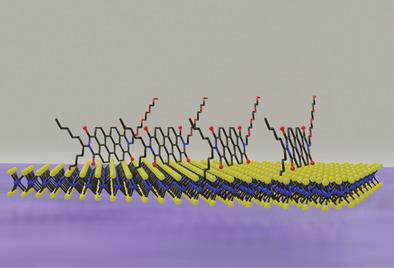当前位置:
X-MOL 学术
›
Adv. Electron. Mater.
›
论文详情
Our official English website, www.x-mol.net, welcomes your feedback! (Note: you will need to create a separate account there.)
Highly Selective Non-Covalent On-Chip Functionalization of Layered Materials
Advanced Electronic Materials ( IF 6.2 ) Pub Date : 2021-01-15 , DOI: 10.1002/aelm.202000564 Rita Tilmann 1 , Corinna Weiß 2 , Conor P. Cullen 3 , Lisanne Peters 3 , Oliver Hartwig 1 , Laura Höltgen 1 , Tanja Stimpel‐Lindner 1 , Kathrin C. Knirsch 2 , Niall McEvoy 2, 3 , Andreas Hirsch 2 , Georg S. Duesberg 1, 3
Advanced Electronic Materials ( IF 6.2 ) Pub Date : 2021-01-15 , DOI: 10.1002/aelm.202000564 Rita Tilmann 1 , Corinna Weiß 2 , Conor P. Cullen 3 , Lisanne Peters 3 , Oliver Hartwig 1 , Laura Höltgen 1 , Tanja Stimpel‐Lindner 1 , Kathrin C. Knirsch 2 , Niall McEvoy 2, 3 , Andreas Hirsch 2 , Georg S. Duesberg 1, 3
Affiliation

|
Non-covalent functionalization of layered 2D materials is an essential tool to modify and fully harness their optical, electrical, and chemical properties. Herein, a facile method enabling the selective formation of self-assembled monolayers (SAMs) of perylene bisimide (PBI) on transition metal dichalcogenides (TMDs), directly on the growth substrate (on-chip), is presented. Laterally-resolved infrared atomic force microscopy (AFM-IR) and time-of-flight secondary ion mass spectrometry (TOF-SIMS) are applied as superior techniques to gain detailed information beyond traditional surface analysis techniques, such as Raman spectroscopy and AFM, on TMD/PBI structures. The highly selective functionalization conducted in organic solution on MoS2 and WSe2 opens up a pathway to controllable, versatile functionalization of layered materials, which is highly sought after for its potential in passivation, tuning of properties and applications in optics, electronics, and (bio-) sensing.
中文翻译:

层状材料的高选择性非共价片上功能化
层状二维材料的非共价功能化是修改和充分利用其光学、电学和化学性质的重要工具。在此,提出了一种简便的方法,可以直接在生长基板(片上)上在过渡金属二硫属化物(TMD)上选择性形成苝双酰亚胺(PBI)的自组装单层(SAM)。横向分辨红外原子力显微镜 (AFM-IR) 和飞行时间二次离子质谱法 (TOF-SIMS) 被用作卓越的技术,以获得超越传统表面分析技术(如拉曼光谱和 AFM)的详细信息。 TMD/PBI 结构。在有机溶液中对 MoS 2和 WSe 2进行高选择性功能化 为层状材料的可控、多功能功能化开辟了一条途径,该材料因其在钝化、性能调整和光学、电子和(生物)传感方面的应用方面的潜力而备受追捧。
更新日期:2021-01-15
中文翻译:

层状材料的高选择性非共价片上功能化
层状二维材料的非共价功能化是修改和充分利用其光学、电学和化学性质的重要工具。在此,提出了一种简便的方法,可以直接在生长基板(片上)上在过渡金属二硫属化物(TMD)上选择性形成苝双酰亚胺(PBI)的自组装单层(SAM)。横向分辨红外原子力显微镜 (AFM-IR) 和飞行时间二次离子质谱法 (TOF-SIMS) 被用作卓越的技术,以获得超越传统表面分析技术(如拉曼光谱和 AFM)的详细信息。 TMD/PBI 结构。在有机溶液中对 MoS 2和 WSe 2进行高选择性功能化 为层状材料的可控、多功能功能化开辟了一条途径,该材料因其在钝化、性能调整和光学、电子和(生物)传感方面的应用方面的潜力而备受追捧。



























 京公网安备 11010802027423号
京公网安备 11010802027423号